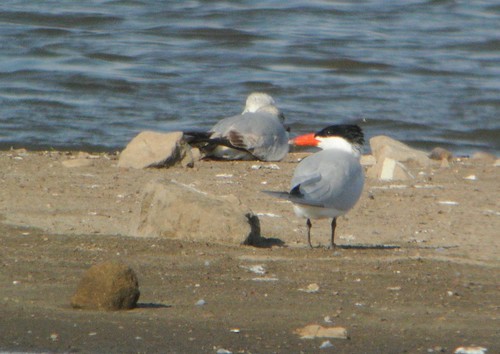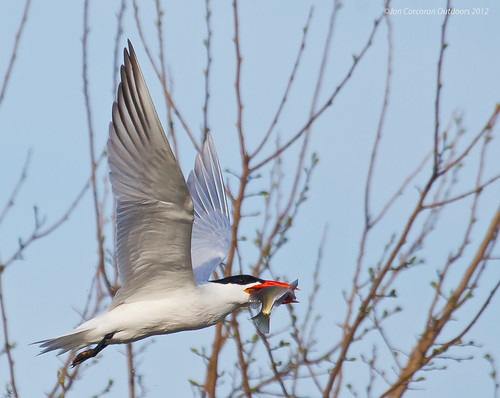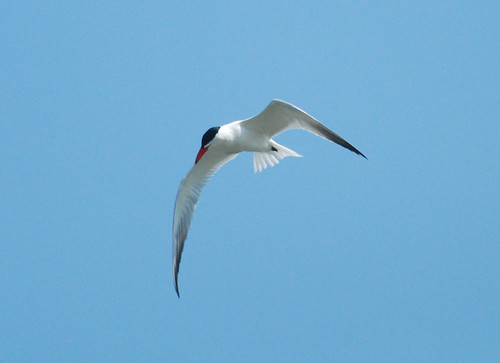Caspian Tern
(Hydroprogne caspia)
Conservation • Description • Habitat • Ecology • Distribution • Taxonomy
Conservation Status |
|
|||||||
| IUCN Red List | LC - Least Concern |
|||||||
| NatureServe | N4N5B, N5N - Apparently Secure to Secure Breeding, Secure Nonbreeding SNRM - Unranked Migrant |
|||||||
| Minnesota | not listed |
|||||||
Description |
||
This is a large tern, the world“s largest. The bill is thick and reddish-orange with a small black tip. The outer primary feathers, seen from below in flight, are very dark. The legs are black. |
||
Size |
||
19″ to 23″in length 48″ to 54″wingspan |
||
Voice |
||
Similar Species |
||
Common Tern (Sterna hirundo) is much smaller. The legs are red. Forster’s Tern (Sterna forsteri) is much smaller. The legs are orange. |
||
Habitat |
||
Breeding: Islands in lakes and rivers Migration: Wetlands, shores of large lakes and rivers |
||
Ecology |
||
Migration |
||
Late April to mid-June and mid-July to mid-October |
||
Nesting |
||
|
||
Food |
||
Small fish, tadpoles, and aquatic invertebrates |
||
Distribution |
||||
Occurrence |
||||
Uncommon migrant |
||||
Maps |
||||
The Minnesota Ornithologists’ Union All Seasons Species Occurrence Map |
||||
Taxonomy |
|||
| Class | Aves (birds) | ||
Order |
Charadriiformes (shorebirds and allies) | ||
Family |
Laridae (gulls, terns, and skimmers) | ||
Subfamily |
Sterninae (terns and noddies) | ||
Genus |
Hydroprogne | ||
Caspian Tern was formerly placed in the Genus Sterna. Based on mitochondrial DNA analysis in 2004 it was placed alone in its own genus. There are no subspecies. |
|||
Synonyms |
|||
Sterna caspia |
|||
Visitor Photos |
|||||
Share your photo of this bird. |
|||||
| This button not working for you? Simply email us at info@MinnesotaSeasons.com. Attach one or more photos and, if you like, a caption. |
|||||
Lynn Rubey |
|||||
A breeding Caspian Tern in flight near the West Pool area of The Big Stone National Wildlife Refuge. |
|||||
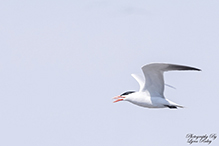 |
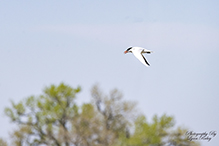 |
||||
MinnesotaSeasons.com Photos |
|||||
|
|||||


Visitor Videos |
|||
Share your video of this bird. |
|||
| This button not working for you? Simply email us at info@MinnesotaSeasons.com. Attach a video, a YouTube link, or a cloud storage link. |
|||
Other Videos |
|||
| Caspian Terns Up Close & Personal Elkhorn Slough Foundation |
|||
About
Uploaded on Feb 22, 2009 Bruce Lyons, a University of Santa Cruz professor, gives an intimate look into Caspian Tern life at the Elkhorn Slough. Visit http://ElkhornSlough.org for more information on how you can protect wildlife at the the Elkhorn Slough. Filmed, narrated, and copyrighted by Bruce Lyons, 2004. |
|||
| Caspian Tern LabofOrnithology |
|||
About
Published on Jun 5, 2015 Juvenile Caspian Terns follow their parents after leaving the nesting colony. Listen to the begging call given by this juvenile. ML Video #447038; video recorded by David O. Brown. For more bird videos and sounds, explore the Macaulay Library at the Cornell Lab of Ornithology. http://macaulaylibrary.org For additional identification and life history information visit: http://www.allaboutbirds.org/guide/caspian_tern/id |
|||
| Caspian Tern,Sterna caspia, preening Rob Curtis |
|||
About
Published on Apr 23, 2014 Caspian Tern, Sterna caspia preening. |
|||
| Birds USA... Caspian Terns groenelantaarn |
|||
About
Published on Sep 12, 2013 Birding trip with Roman and Vicky... |
|||
| Caspian Tern Colony Phil Armishaw |
|||
About
Published on Jul 19, 2015 One of the Caspian Tern Colonies in Hamilton, Ontario, Canada The Terns share the island with hundreds of Double--Crested Cormorants and lots of Gulls. The adult Terns are bringing fish back to the colony and than the search begins for their young. It is not an easy task and you will see lots of youngsters trying to mooch food, but the adults will only feed their own. In the last scene a Tern finally finds it's juvenile and feeds it. Another adult fails when a Gull steals the fish. |
|||


|
Created: Last Updated: © MinnesotaSeasons.com. All rights reserved. |
